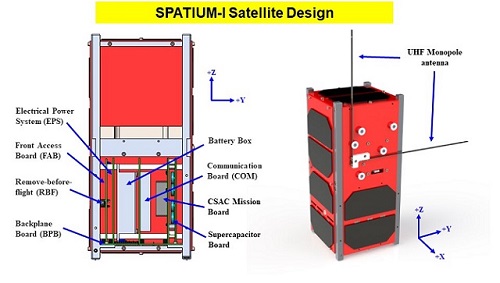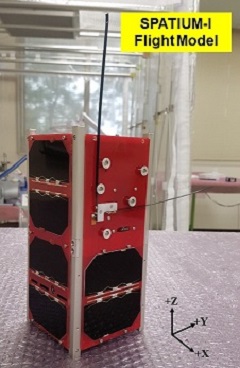SPATIUM
SPATIUM (Space Precision Atomic-Clock Timing Utility Mission)
The SPATIUM program is a joint collaboration between Nanyang Technological University, Singapore and Kyushu Institute of Technology, Japan. The primary scientific objective of SPATIUM program is to develop a reliable platform that derives the three-dimensional global ionosphere plasma distribution with excellent spatial and temporal resolutions. The ionosphere total electron contents (TEC) will be modeled based on multipoint measurements of phase-shift in satellite clock signal from a constellation of CubeSats carrying a high precision timing reference.
The pathfinder satellite, SPATIUM-I, was carried to the International Space Station (ISS) by KOUNOTORI HTV7 cargo transporter which was successfully launched on 23 Sep 2018. The satellite was deployed from the ISS Japanese Kibo module on 6 Oct 2018 at 15:45 pm SGT. This 2U CubeSat is the first nanosatellite in the world to successfully demonstrate a chip scale atomic clock (CSAC) working in Low Earth Orbit. This demonstrates that the ‘Built-at-NTU’ atomic clock keeps time with a stability of 0.2 billionths in a second, on a par with satellites a thousand times bigger.


SPATIUM (Space Precision Atomic-Clock Timing Utility Mission)
The SPATIUM program is a joint collaboration between Nanyang Technological University, Singapore and Kyushu Institute of Technology, Japan. The primary scientific objective of SPATIUM program is to develop a reliable platform that derives the three-dimensional global ionosphere plasma distribution with excellent spatial and temporal resolutions. The ionosphere total electron contents (TEC) will be modeled based on multipoint measurements of phase-shift in satellite clock signal from a constellation of CubeSats carrying a high precision timing reference.
The pathfinder satellite, SPATIUM-I, was carried to the International Space Station (ISS) by KOUNOTORI HTV7 cargo transporter which was successfully launched on 23 Sep 2018. The satellite was deployed from the ISS Japanese Kibo module on 6 Oct 2018 at 15:45 pm SGT. This 2U CubeSat is the first nanosatellite in the world to successfully demonstrate a chip scale atomic clock (CSAC) working in Low Earth Orbit. This demonstrates that the ‘Built-at-NTU’ atomic clock keeps time with a stability of 0.2 billionths in a second, on a par with satellites a thousand times bigger.
Technical Fact
| Satellite Specification | |
| Dimension | 200 mm x 100 mm x 100 mm |
| Mass | 2660 grams |
| Expected Lifetime | 12 months |
| Launch Date | 23 Sep 2018 |
| Orbit | LEO, 400 km altitude, 51.6 degree inclination |
| Communication | Uplink: 401.040MHz Downlink: 400.960MHz (Phase Modulation) 467.674MHz (Spread-Spectrum Modulation) |
| CSAC Mission Board Specification | |
| Dimension | 86.3 mm x 90 mm x 21 mm |
| Mass | 113 grams |
| Voltage Supply | 4.5 V |
| Power Consumption | 0.35 W |
| Warm-up Time | < 180 s |
| Data Interface | CSAC data: UART serial communication. Baud rate: 57,600 bps Operation data: UART serial communication. Baud rate: 128,000 bps |

